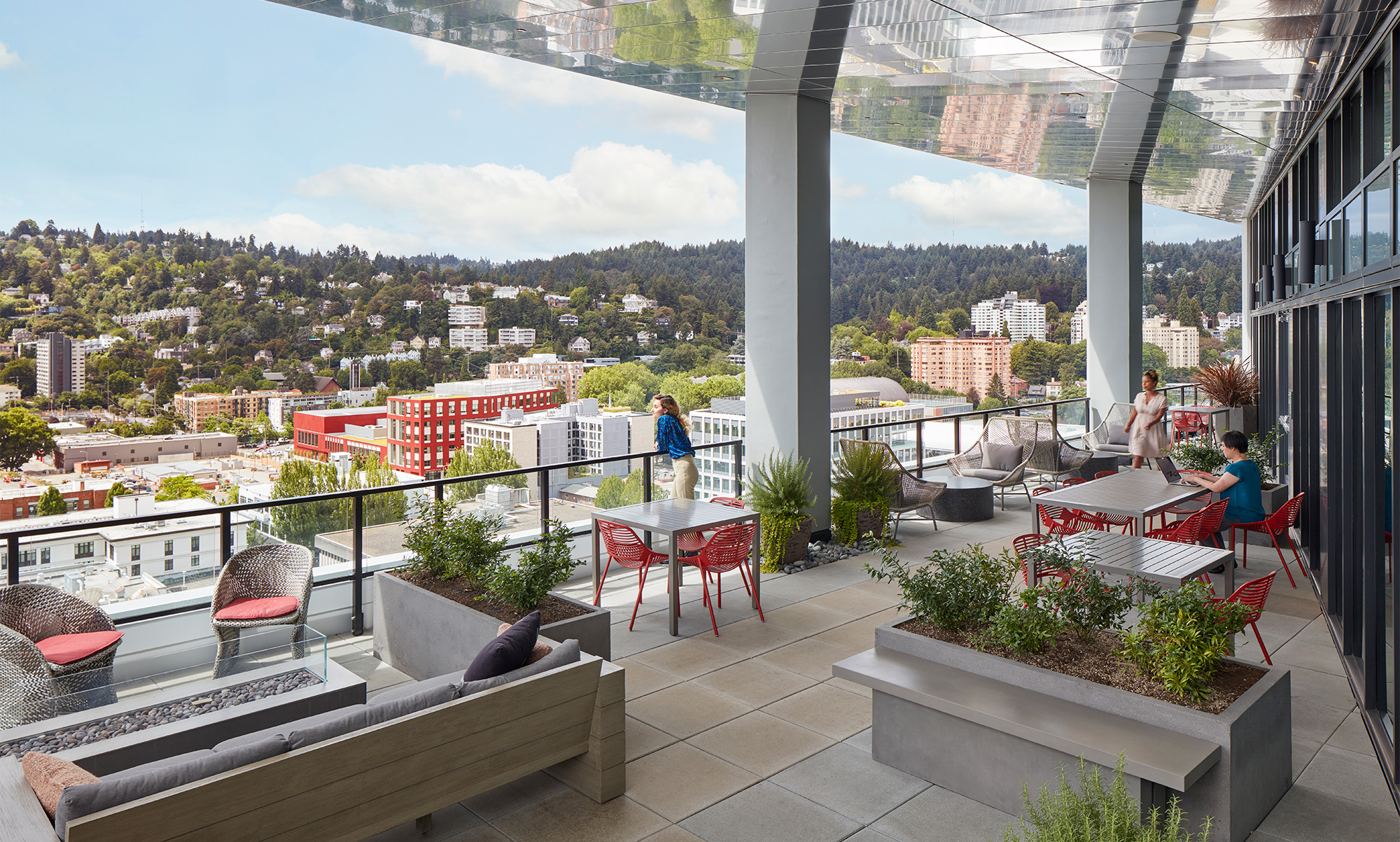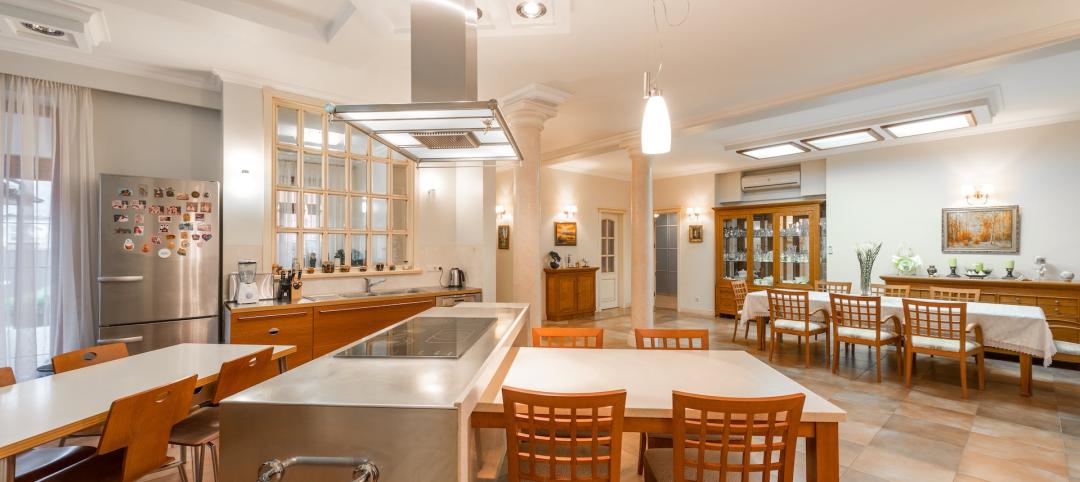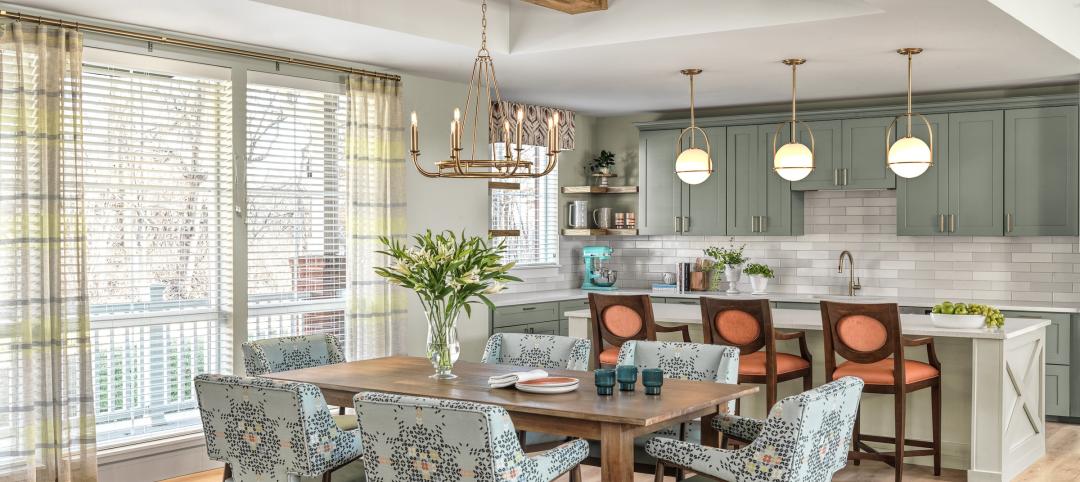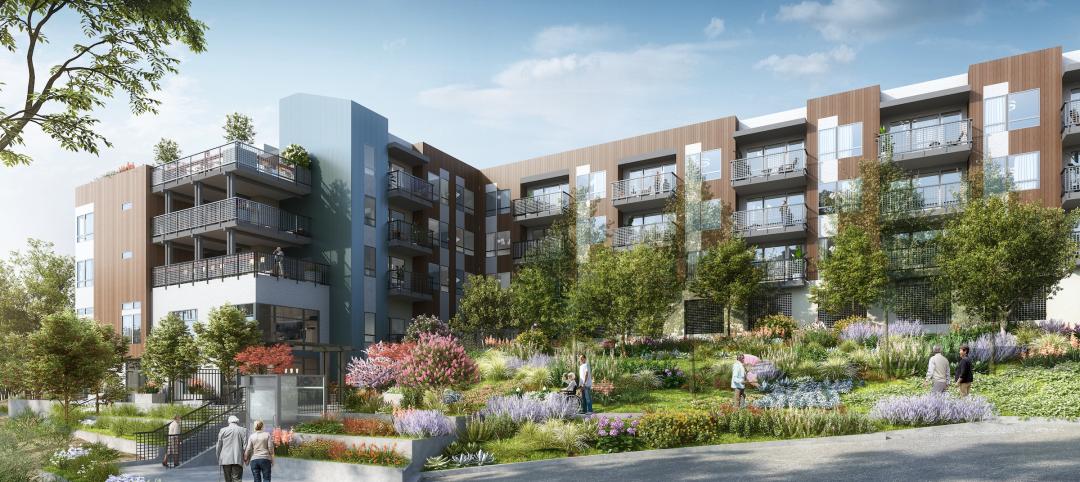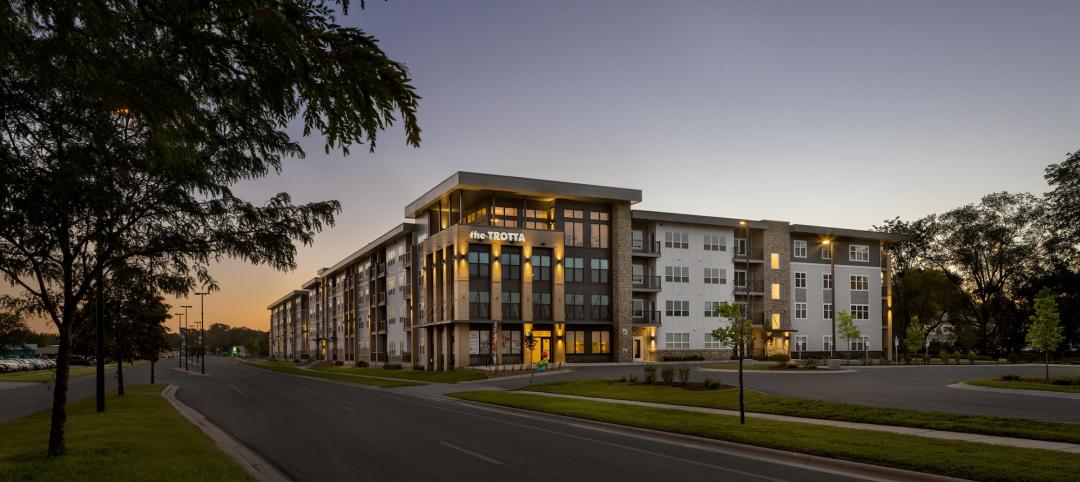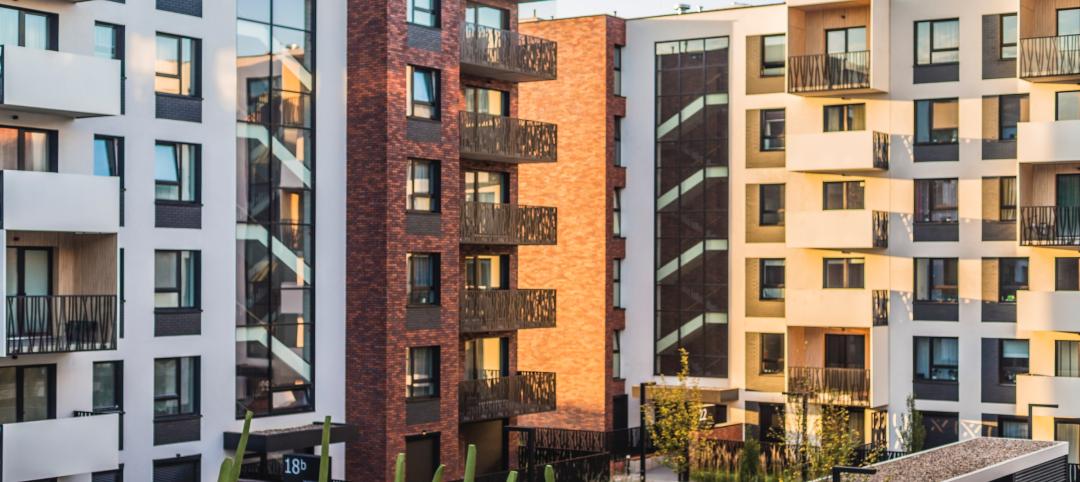This article first appeared in BD+C's 2023 Multifamily Annual Report—our first-ever “state of the state” special report on the multifamily housing construction sector. To download the full 76-page report, click here.
Demand for market-rate multifamily housing is “super strong,” says Meaghan McGee, PE, LEED AP, Senior Associate with the AE firm Kimley-Horn in Denver. Demographic and economic shifts, along with work and lifestyle changes, some of them agitated by the recent coronavirus pandemic, have made apartment living preferable for a wider range of buyers and renters. And construction activity is buzzing, with “a lot of Class A buildings coming online,” says Caitlin Surgue Walter, Vice President with the National Multi Housing Council. The Sunbelt is the prime market.
But construction isn’t coming anywhere near closing the gap separating supply and demand for affordable multifamily housing, Walter laments. “We’ve been underbuilding for so long.” McGee adds that tougher codes and regulations, higher impact fees, and energy and water concerns are among the factors that hold up permits.
Rising interest rates, coupled with supply chain and manpower shortages, have made construction more expensive. “There’s only so much you can do to lower costs to what people can afford,” says Walter Hughes, Chief Innovation Officer for Humphreys & Partners Architects. In Florida, a multifamily hot spot, commercial-property insurance has doubled In the past year, reports the Wall Street Journal, causing some developers there to hold off on projects. “Nothing is starting in a timely manner,” observes Scott Skidelsky, Balfour Beatty US’s Southeast Region President.
This good-news/bad news scenario is reflected in the following trends we’ve identified—based on interviews with 14 AEC firms and news releases from developers—that currently impact the market-rate multifamily sector, and provide clues about where it’s headed.
1. The incredible shrinking apartments
Apartments will continue to get smaller. Last year, the U.S. housing market saw the sharpest drop in multifamily apartment size in a decade. Citing a Yardi Matrix survey of 100 cities, Rent Café estimated the average size of new apartments, at 887 sf, was 30 sf smaller than in the previous year, and 54 sf smaller than in 2012.
Lee DeLong, CEO-Capital Group for Clark Construction in McLean, Va., observes that shrinkage could be attributable to a change in “blending,” with greater emphasis on one-bedroom apartments to increase an apartment building’s density and, presumably, its return on investment. Smaller apartments are also a response to this sector’s affordability dilemma that, in June, found the national median rent price at $2,029 per month, 15.5% higher than the same month in 2021, according to the website Rent.com.
Apartment shrinkage has boosted demand for flexible furnishings. “When you’re marketing smaller spaces at a premium, the furnished option is a selling point,” says Steve Spett, Co-founder of Resource Furniture, the largest distributor of multifunctional furniture in North America. Notably, the smaller-apartment trend coincides with demand for “highly amenitized spaces” within apartment buildings, says Kinjai Patel, Lendlease’s Central Region Executive GM-Construction.
But the ongoing demographic migration to suburbs in the South and West is also influencing apartment size: All but one (Overland Park, Kan.) of Rent Café’s top 15 cities with the largest average new apartment sizes are in these regions.
2. Designing for remote work
Remote work, a Covid remnant, is still a design consideration. Despite businesses nudging workers back into offices, a recent survey conducted by Pew Research Center found that 35% of Americans with jobs that can be performed remotely (about two-fifths of the total workforce) toils from home full time, and that 41% is working a hybrid office/home work schedule. “The pandemic made people rethink how they use space,” says NMHC’s Walter.
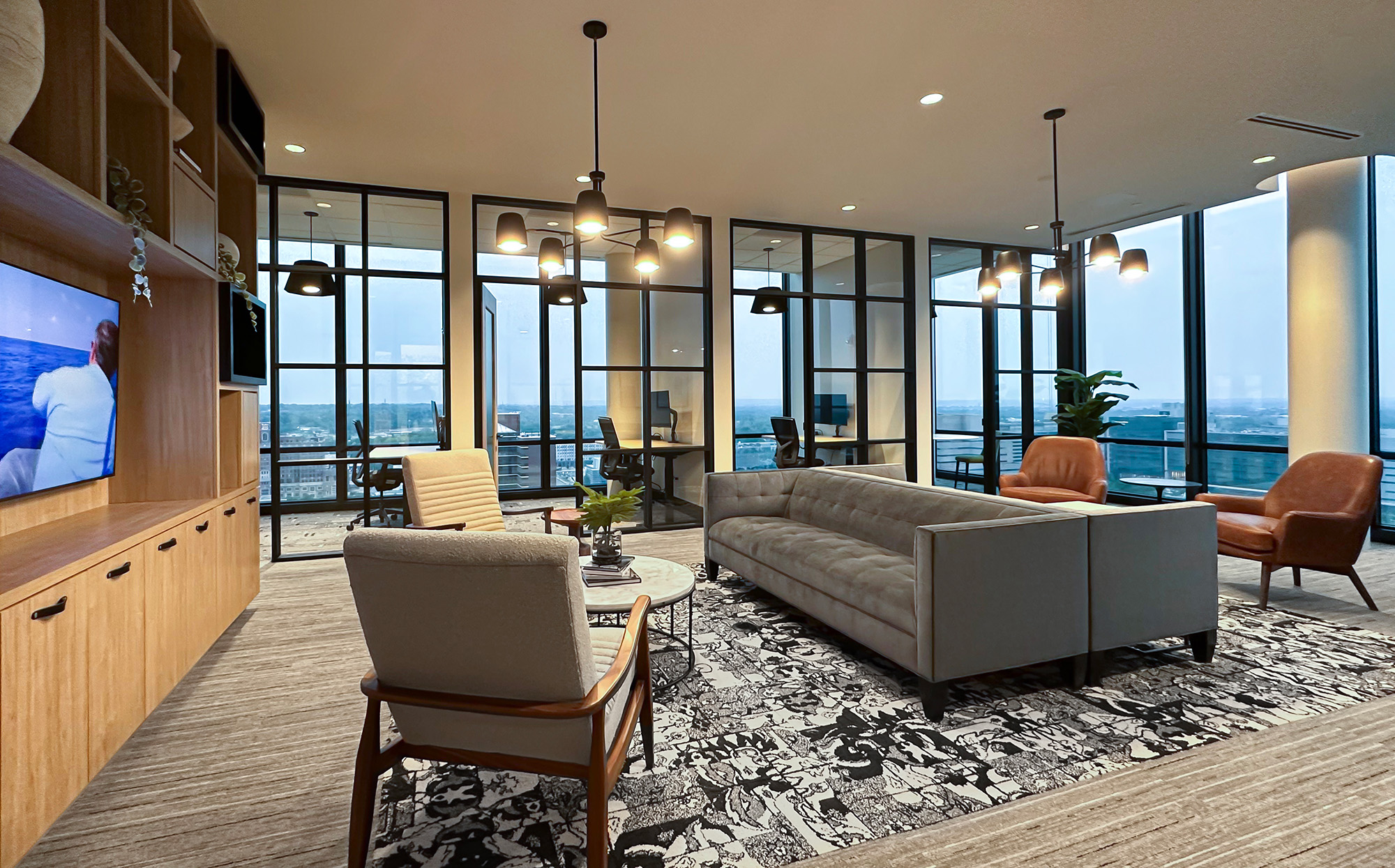
Newer apartment buildings include among their amenities lounge-like common areas where people work both collaboratively and in private. That’s also meant giving tenants better access to daylighting, fresh air, and technology, says Hughes of Humphreys & Partners.
Even as apartments get smaller, developers are carving out work-at-home spaces “without lowering their densities or increasing cost too much,” says Tim Haley, MBH Architects’ Project Architect and Senior Associate. Creating these Private Idahos is now “a national trend,” adds Mike DeRouin, President of Chicago-based Fitzgerald Associates Architects, whom BD+C interviewed with Project Manager Ryan Tapak.
3. Electrification codes
Codes shift to all-electric for new construction. Last January, the nation’s first statewide building code to include highly efficient heat pumps as baseline technology went into effect in California. As a result, most new homes and buildings there will be equipped with heat pumps or must meet higher energy efficiency standards. The law’s requirements for electric appliances were expected to prompt developers to forego gas in new construction in that state. Next year, a similar law goes into effect in New York, where the installation of fossil fuel equipment must cease in new buildings up to seven stories in 2026 and in new larger buildings by 2029.
While all-electric regs aren’t at the groundswell stage yet nationwide, pockets of transformation are occurring. The engineering firm Thornton Tomasetti is voluntarily deploying heat pump technology in two multifamily projects in Portland, Maine. Heat pumps make all-electric options more feasible for taller buildings, explains Michael Pulaski, the firm’s Sustainability Practice Lead, whom BD+C interviewed with Ethan Rhile, PE, Vice President and Structures Practice Lead.
Pulaski notes that 10 communities in Massachusetts, including Boston and Cambridge, need to comply with a fossil fuel ban in new buildings by early next year. Nearly 100 municipalities in 11 states require or encourage the switch to electric heating, cooling and cooking, according to an analysis by the Building Decarbonization Coalition, which estimates that one in five Americans is now covered by those policies.
4. Office-to-res? Wait a minute!
Office-to-residential conversions remain exceptions. Between 2012 and 2022, 15.6 million households were formed in the U.S., but only 11.9 million single- and multifamily homes were completed, according to Realtor.com. This chronic housing shortage is driving the adaptive reuse of other building types to residential. Dallas-based architecture firm Premier, in collaboration with Michael Graves Architecture & Design and Claremont Development, is converting St. Lucy’s Church in Jersey City, N.J., into a 23-story residential tower with 444 luxury apartments. Fitzgerald has converted several hospitals to housing. Humphreys & Partners is working on three or four shopping mall-to-res conversions.
Offices represented more than one-third of all building conversions to housing last year. While those conversions were off by 15% to 3,390 apartments in 2022, 45,000 offices are in the process of being converted to apartments, with Los Angeles taking the lead, according to Rent Café.
But Hughes, Humphreys’ CIO, says his firm struggles to get office-to-res conversions to pencil out. The design firm Ankrom Moisan recently looked at three office towers and a hotel in downtown Portland, Ore., and determined their conversion construction costs would be too high, says Jennifer Sanin, AIA, Managing Design Principal.
Office-to-res conversions can cost more than new construction, says NMHC’s Walter. Office floor plates, at 80-90 ft or more, are often too large to allow sufficient sunlight in as apartments, and post-tension slab floors can’t be cut, says MBH’s Haley. Offices usually don’t have operable windows that residential codes mandate; in fact, such conversions—which are typically of older buildings—can require significant upgrades. Facades, elevators, and bathrooms in office buildings can be unsuitable for apartment buildings.
“Redevelopment of existing buildings takes patience,” says Kimley-Horn’s McGee. Even then, it’s nearly impossible to convert offices to affordable housing without tax breaks, she and others say.
In its analysis of 300 office buildings in 25 cities in North America last year, Gensler concluded that only 30% were suitable for conversion to residential. A sticking point, says Brooks Howell, Gensler’s Global Residential Practice Leader in Houston: “Owners haven’t gotten religion yet about what their buildings are actually worth.”
One of the buildings evaluated was an office tower in Baton Rouge, La., whose sole tenant was Chase Bank. Gensler and the GC Lemoine Companies converted floors 8 through 21 to 168 apartments that are marketed as Residences at Rivermark. Howell says the building’s pan-joist structure made the conversion easier.
Some cities with vacant office gluts are trying to make conversions more appealing. Calgary, Alberta, which wants to remove six million sf of office space from its downtown by 2031, incentivizes developers with $75 per sf grants. In June, San Francisco introduced an initiative that encourages conversions of offices to housing or other uses through regulatory modifications that accelerate the process. Indeed, there is a range of state legislation in California that may help facilitate conversions, with more being proposed.
5. Modular and prefab options
Multifamily plays catchup with modular and prefab. With few exceptions, market-rate multifamily developers haven’t been bullish on modular design and offsite construction. Clark Construction’s DeLong isn’t seeing much demand. “For multifamily, prefab isn’t cheaper” than site built, says Balfour Beatty’s Skidelsky.
The franchised homebuilder Epcon Communities has investigated modular “many times,” but has yet to find a workable solution. “Our [townhouse] product is too deep and contains too many areas of open space to modularize effectively,” explains Paul Hanson, President of Epcon Financing. Plus, Epcon’s townhouses are nearly 100% on-slab construction, and modular providers require a crawl space, at a minimum, to set the building above.
While modular works best for reiterative design, in Chicago, “the sophisticated renter doesn’t like cookie cutter,” says Lendlease’s Patel.
Patel is seeing some breakthroughs for affordable housing. That’s the tenant the developer Greystar is targeting with its new Ltd. by Greystar product that’s made at the company’s Modern Living Solutions (MLS) factory in Knox, Pa. The factory’s annual capacity of 1,200 apartments can serve a 500-mile market radius. Greystar has five Ltd. projects underway in four cities with about 1,600 apartments expected to come online by the end of 2024, starting with the 378-unit Med Center in Houston.
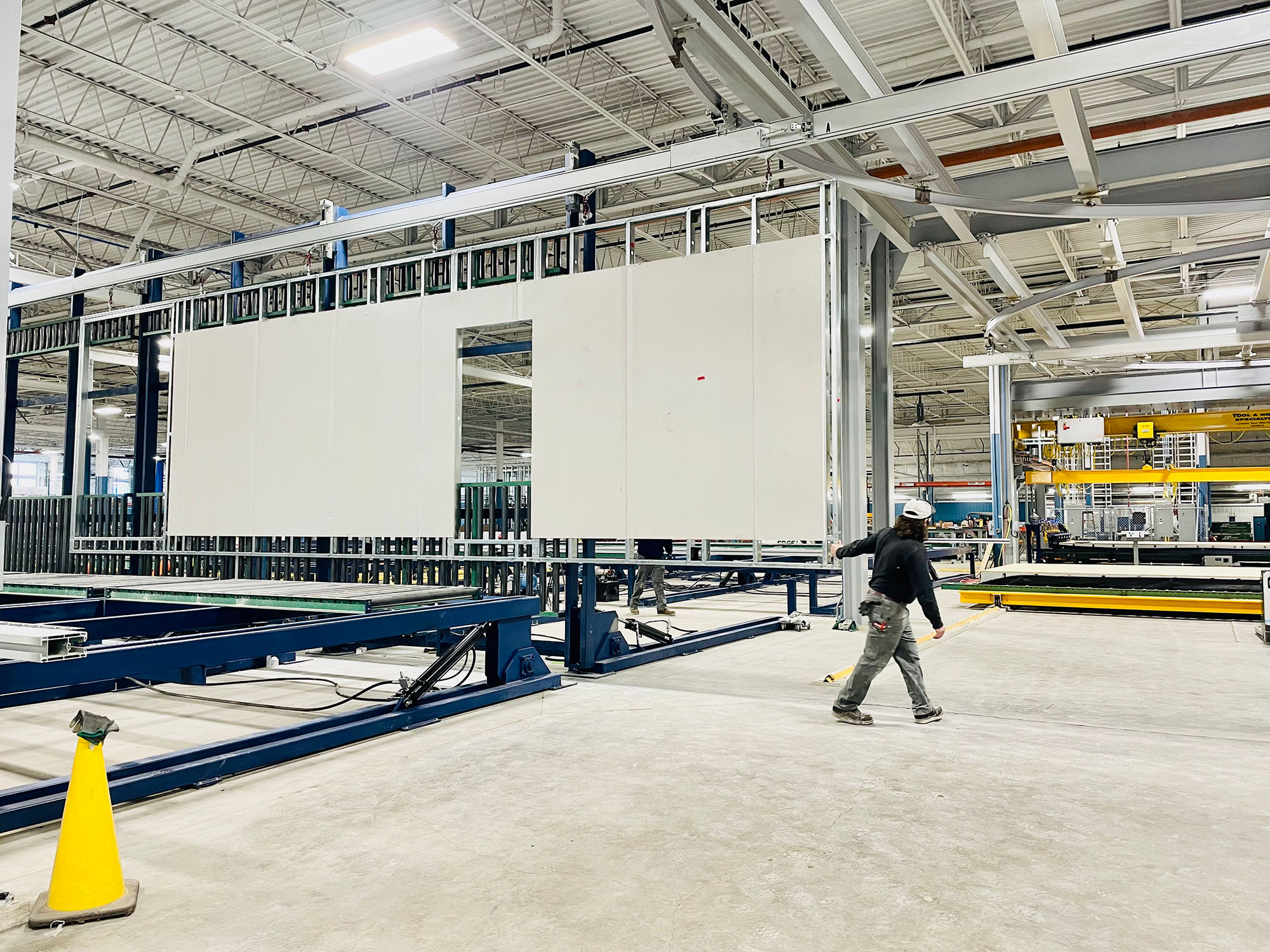
Andy Mest, MLS’s Managing Director, says Ltd. apartments are being marketed primarily to the “missing middle”: teachers, cops, and others who can’t afford to live close to where they work. He adds that vertical integration of manufacturing, developing, and building is the key to success. A typical building has 52 apartments ranging from 680 to 1,400 sf, with communal spaces for work-at home tenants, a gym, and a play area for kids. Most will have pools.
6. Amenities abound
Amenities have gone to the dogs, literally. The COVID-19 pandemic drove pet ownership, which reached 70% of U.S. households in 2022, according to the American Pet Product Association. So it’s not surprising that pet-related amenities, like washing stations and trails, are more in demand among apartment dwellers than ever. One of Kimley-Horn’s recent multifamily projects has a rooftop with a dog track where owners socialize.
Perennially in-demand amenities—pools, fitness centers, washers and dryers, bike storage—are now part of a longer list that leans toward health, wellness, and socialization (pickle ball, anyone?). Ankrom Moisan’s Sanin has seen hypo-allergenic salt rooms added to apartment buildings. Walter of NMHC points to podcasting rooms in common areas. Epcon’s communities offer three clubhouse prototypes.
“You can’t get enough square footage on the first floor to handle the package deliveries people now receive,” says Balfour Beatty’s Skidelsky. Apartment buildings in general must also present tenants with a sense of safety and security, says McGee; that includes giving them a measure of control over their apartments’ environment, like temperature and sound.
7. Mixed use and the connection to community
Mixed use broadens apartment buildings' appeal. Most multifamily buildings are not mixed use. But AEC sources note that customers are seeking convenience and connection with their communities beyond ground-floor retail and bodegas.
Fitzgerald’s DeRouin points to Artisan, a 24-story high rise with 298 apartments, which opened in June in Cleveland’s University Circle neighborhood. The building’s amenities include rooms for yoga and sports simulation, a pool, and coworking space.
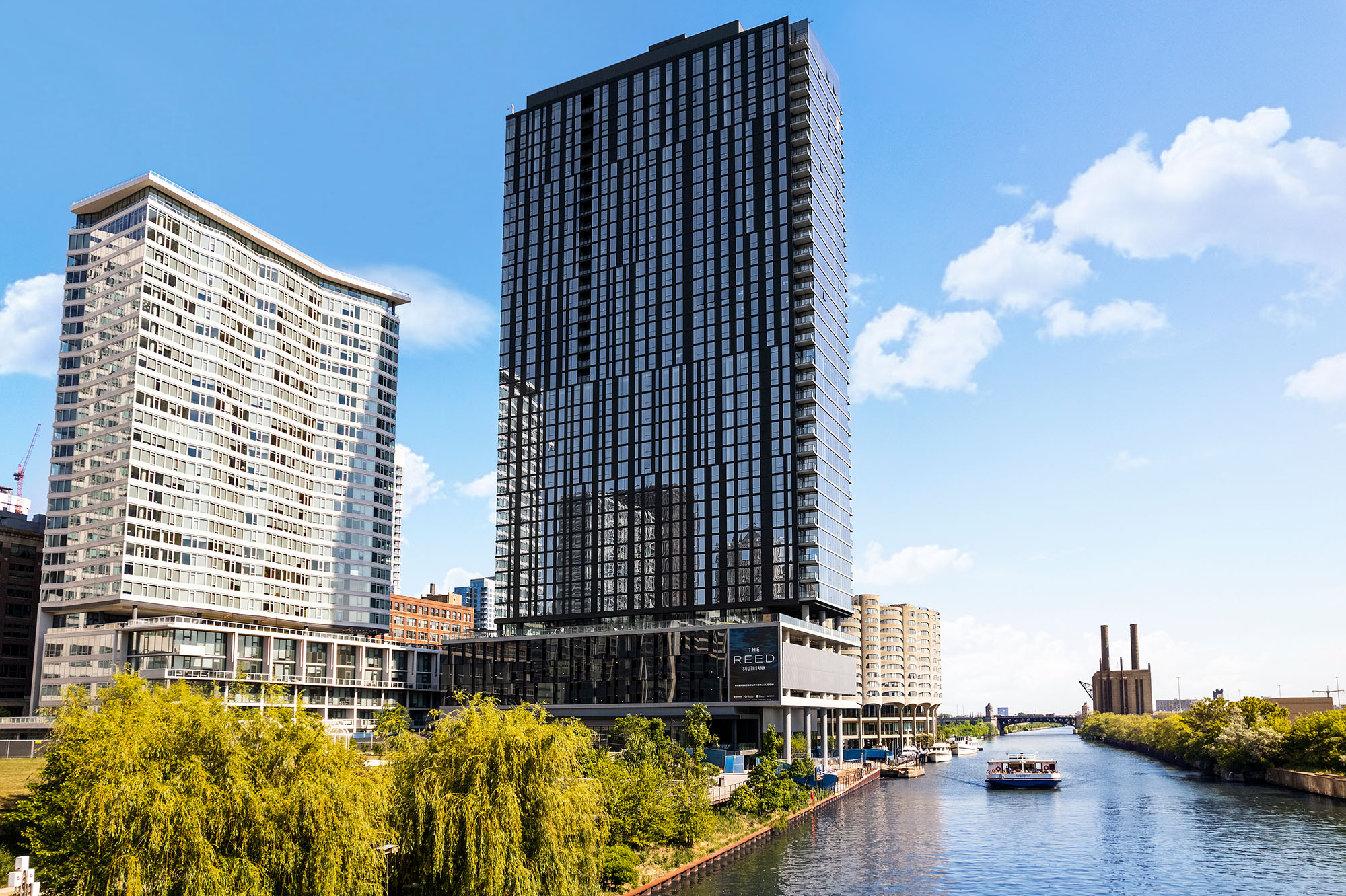
Artisan is the first completed component of the Circle Square’s master plan that features more retail, a relocation of the Martin Luther King branch of the Cleveland Public Library, and connection to Cleveland Clinic, all within walking distance of the building.
Lendlease’s 41-story The Reed at Southbank in Chicago, designed by Perkins & Will, with 224 apartments and 218 for-sale condos, includes as 12,000-sf outdoor deck with pool and cabanas. The tower borders Southbank Park, a two-acre greenspace that’s the heart of a seven-acre master plan, and an adjacent riverwalk programmed with a viewing platform, seating areas, and a natural stone amphitheater.
8. Multifamily housing comes in all sizes
Low and midrise prevail, but towers keep rising, too. Even as developers vie for “tallest building” status, low- and midrise apartment buildings still dominate in most markets, and greater density is an abiding objective.
“We’re constantly re-evaluating buildings and units for optimization,” says Skidelsky of Balfour Beatty, whose projects are mostly 3-4 story Type 5 wood framed buildings, or high rises like the two-tower, 24-story, 399-unit Icon Marina Village in West Palm Beach, Fla., which opened in June. (He says Balfour Beatty tends to avoid Type 3 buildings because their concrete components require “mixing trades.”)
For Humphreys & Partners, the prevailing multifamily building is two to three stories tall, wood-framed, 30 units to the acre, with surface parking. Hughes says his firm’s products generally offer developers 10-15% more rentable space than competitors, and points to Northeast Austin, where Humphreys, in collaboration with GC Blackburn Communities, debuted its e-STAK townhouse-within-an-apartment concept at Loyola Junction, which squeezed 396 units into three floors.
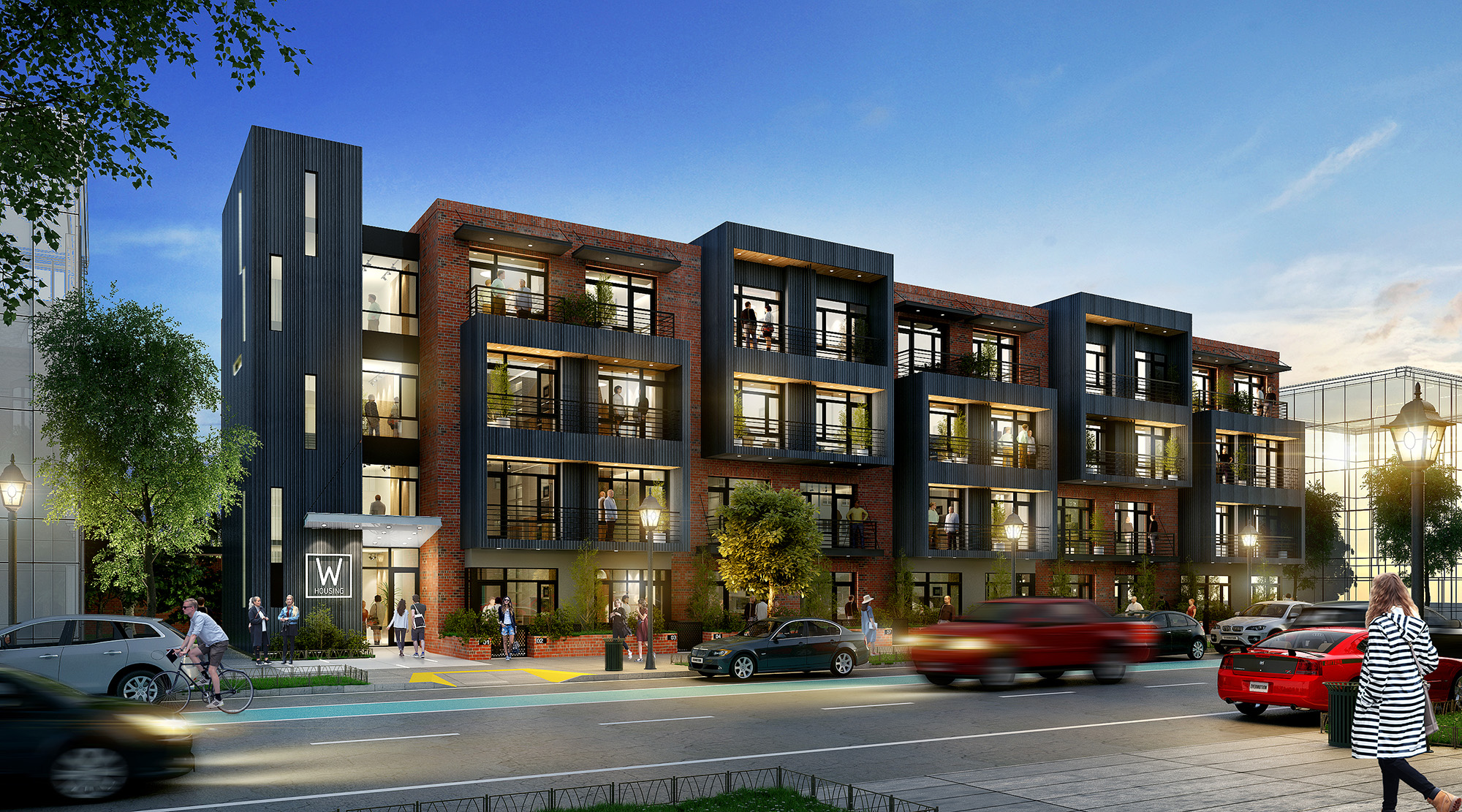
Kimley-Horn works on “all kinds of multifamily,” says McGee. She notes, though, that greenfield projects are mostly garden-style apartment buildings that appeal to active-adult renters. As building codes allow the use of mass timber for taller structures, Thornton Tomasetti is seeing engineered lumber being specified more frequently. (Thornton Tomasetti was on the Building Team for Ascent, the 25-story, 493,000-sf mixed-use residential tower in Milwaukee, Wis., that’s the tallest mass timber building in the world.)
While most of Lendlease’s projects are new construction, a lot of its pipeline, says Patel, is for “repositioning.” Lendlease is pursuing redevelopment projects like the LaSalle Street Reimagined initiative in Chicago, which is taking a portion of the street’s 5 million sf of vacant historic buildings and recreating them for 1,600-plus units of mixed-use housing.
High rises and supertalls remain the glamor projects. Among the tallest buildings under construction in the U.S. is the 74-story, 352-apartment Waterline in Austin that, at 1,022 ft, will be the tallest building in Texas once it’s completed in 2026. Waterline will include 703,000 sf of office space, 27,000 sf of ground-floor retail, and 35,000 sf of indoor/outdoor amenities. The $426 million 100-story Waldorf Astoria Hotel and Residences in Miami lays claim to being the tallest building south of Manhattan. When completed in 2027, it will be 1,049 ft, and offer 360 condos, including a five-floor 33,000-sf penthouse.
9. Sustainability now top of mind
Sustainability is now on owners' and tenants' radars. Lendlease has set a goal for all its projects to be absolute zero carbon by 2040. Consequently, discussions around environmental, social, and governance (ESG) initiatives “are becoming top-of-mind conversations,” says Patel. “They might not be first on the list, but they’re on the list.”
Tapak, Fitzgerald’s manager on the Artisan project, notes that there are real estate tax benefits from making buildings sustainable. It’s smart marketing, too, says MBH Architects’ Haley, as more prospective tenants are curious about sustainability, which he attributes to increased media coverage.
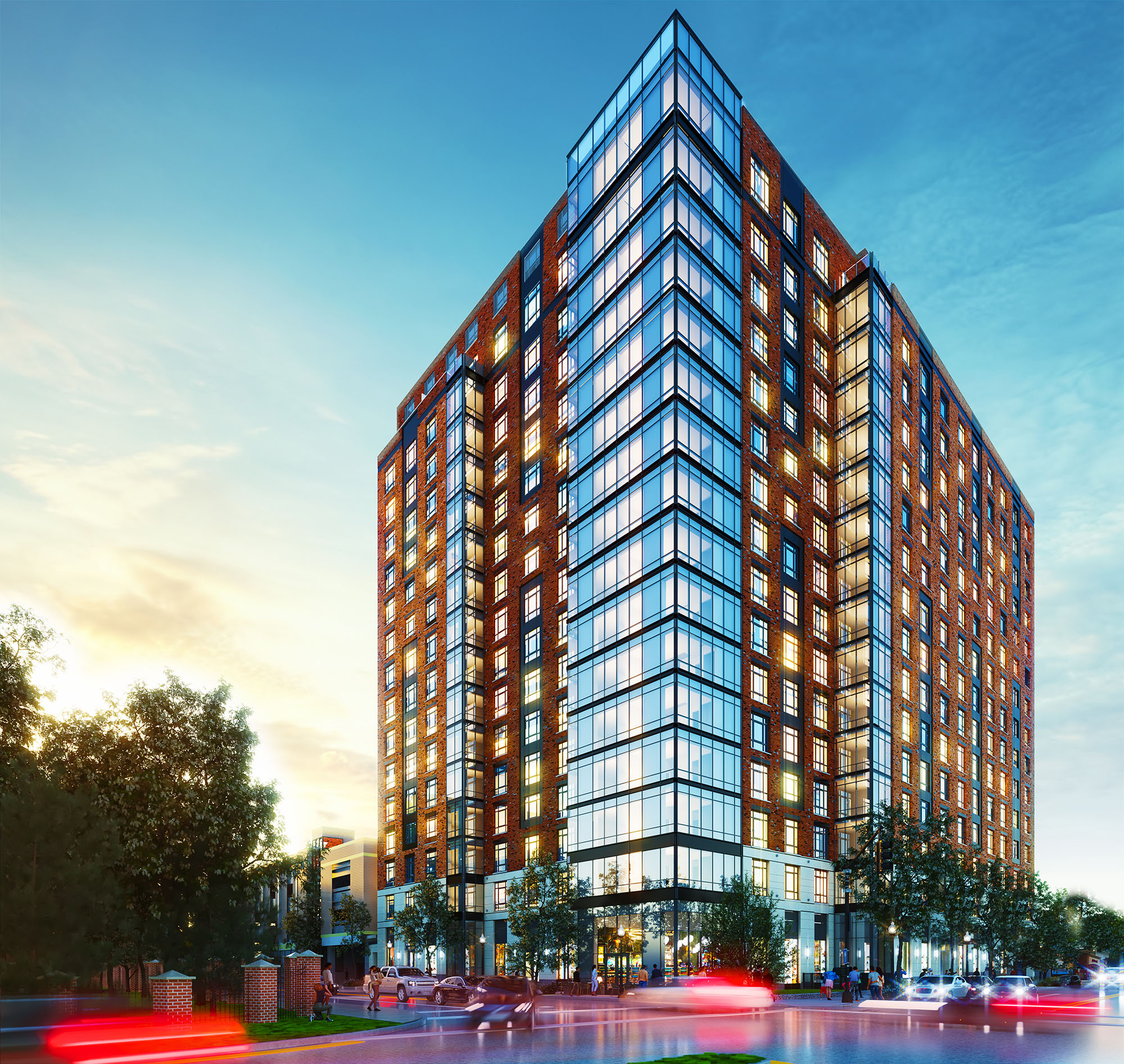
Clark Construction’s DeLong says that, beyond meeting code minimums for performance, his firm maximizes its buildings’ facades and HVAC systems for energy efficiency. And with more developers under the gun to lower their apartment buildings’ carbon footprints, they and their AEC teams are re-examining the construction materials they use and how a building interacts with its environment. Humphreys & Partners, for example, is working with Disney in Orlando on the design of a 1,400-unit multifamily project that will face a wetland, include educational trails, and might incorporate a solar component, says Hughes.
In June, the 16-story 249-apartment 42 Broad in Mount Vernon, N.Y., started leasing. This Perkins Eastman-designed building, developed by Alexander Development Group and The Bluestone Organization, claims to be the world’s largest multifamily high rise to achieve Phius Passive House design certification. It is designed to use up to 80% less energy for heating and cooling than existing buildings through the installation of high-performance windows, extensive insulation, mechanical ventilation, and high-tech building systems that reduce the healing and cooling loads.
10. Keep an eye on production builders
Production builders respond assertively to demand. The top 15 production home builders that market multifamily homes delivered more than 45,000 low-rise (wood framed, four stories or less) multifamily units in 2022, according to Professional Builder magazine, BD+C’s sister publication. That group of builders was led by Lennar, which develops, builds, and manages multifamily properties under its Quarterra Multifamily subsidiary. Among Quarterra’s active projects in July 2023 was Towne Nashville, a 329-home building in Music City’s Germantown neighborhood that started leasing that month; and The Dori, a 222-home community in Doral, Fla., that Quarterra topped off.
Balfour Beatty, says Skidelsky, has been working on several projects for the semicustom home builder Toll Brothers, including one that combines a tower of market-rate apartments with another tower for student housing.
For the past few years, Epcon Communities—which started as a multifamily developer and then switched mostly to single family—has been promoting a four-unit, two-story townhouse product with a master down and an option for a third bedroom and flex room.
While Epcon’s primary customers are active adults, the townhouse product, whose homes sell for around $450,000, has been attracting younger (late 40s) buyers, says Hanson, Epcon Franchising’s president.
Last year, Epcon delivered 144 multifamily buildings, each with eight to 12 bedrooms. Among its recent projects is a 50-unit complex in Cary, N.C., that should be completed in 2024. Epcon, says Hanson, expects townhouses to account for 20% of its construction activity within the next two years.
Want to read more from the Multifamily Annual Report, including additional Top 10 trends articles in affordable housing, senior living, and more? Click here or use the button below to download the full report.
Related Stories
MFPRO+ Research | Mar 6, 2024
Top 10 trends in senior living facilities for 2024
The 65-and-over population is growing faster than any other age group. Architects, engineers, and contractors are coming up with creative senior housing solutions to better serve this burgeoning cohort.
MFPRO+ News | Mar 1, 2024
Housing affordability, speed of construction are top of mind for multifamily architecture and construction firms
The 2023 Multifamily Giants get creative to solve the affordability crisis, while helping their developer clients build faster and more economically.
MFPRO+ Research | Feb 28, 2024
New download: BD+C's 2023 Multifamily Amenities report
New research from Building Design+Construction and Multifamily Pro+ highlights the 127 top amenities that developers, property owners, architects, contractors, and builders are providing in today’s apartment, condominium, student housing, and senior living communities.
MFPRO+ Special Reports | Feb 22, 2024
Crystal Lagoons: A deep dive into real estate's most extreme guest amenity
These year-round, manmade, crystal clear blue lagoons offer a groundbreaking technology with immense potential to redefine the concept of water amenities. However, navigating regulatory challenges and ensuring long-term sustainability are crucial to success with Crystal Lagoons.
Giants 400 | Jan 8, 2024
Top 60 Senior Living Facility Construction Firms for 2023
Whiting-Turner, Ryan Companies US, Weis Builders, Suffolk Construction, and W.E. O'Neil Construction top BD+C's ranking of the nation's largest senior living facility general contractors and construction management (CM) firms for 2023, as reported in the 2023 Giants 400 Report.
Giants 400 | Jan 8, 2024
Top 40 Senior Living Facility Engineering Firms for 2023
Kimley-Horn, Olsson, Tetra Tech, EXP, and IMEG head BD+C's ranking of the nation's largest senior living facility engineering and engineering/architecture (EA) firms for 2023, as reported in the 2023 Giants 400 Report.
Giants 400 | Jan 8, 2024
Top 80 Senior Living Facility Architecture Firms for 2023
Perkins Eastman, Hord Coplan Macht, Lantz-Boggio Architects, Ryan Companies US, and Moseley Architects top BD+C's ranking of the nation's largest senior living facility architecture and architecture engineering (AE) firms for 2023, as reported in the 2023 Giants 400 Report.
Giants 400 | Dec 20, 2023
Top 100 Apartment and Condominium Construction Firms for 2023
Clark Group, Suffolk Construction, Summit Contracting Group, and McShane Companies top BD+C's ranking of the nation's largest apartment building and condominium general contractors and construction management (CM) firms for 2023, as reported in Building Design+Construction's 2023 Giants 400 Report.
Giants 400 | Dec 20, 2023
Top 70 Apartment and Condominium Engineering Firms for 2023
Kimley-Horn, WSP, Tetra Tech, and Thornton Tomasetti head BD+C's ranking of the nation's largest apartment building and condominium engineering and engineering/architecture (EA) firms for 2023, as reported in Building Design+Construction's 2023 Giants 400 Report.
Giants 400 | Dec 20, 2023
Top 160 Apartment and Condominium Architecture Firms for 2023
Gensler, Humphreys and Partners, Solomon Cordwell Buenz, and AO top BD+C's ranking of the nation's largest apartment building and condominium architecture and architecture/engineering (AE) firms for 2023, as reported in Building Design+Construction's 2023 Giants 400 Report.



